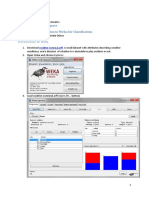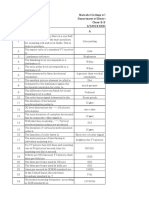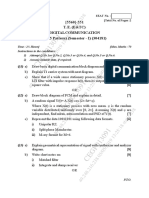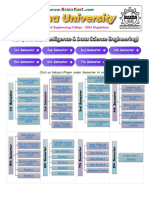Experiment No: 1 Introduction To Data Analytics and Python Fundamentals Page-1/11
Uploaded by
Harshali ManeExperiment No: 1 Introduction To Data Analytics and Python Fundamentals Page-1/11
Uploaded by
Harshali ManeAMRUTVAHINI COLLEGE OF ENGINEERING, SANGAMNER
Data Analytics
Experiment No: 1 Introduction to data analytics and Python fundamentals Page- 1/11
Aim of Experiment:
Introduction to data analytics and Python fundamentals:
Understanding the Data.
Python Packages for Data Science.
Importing and Exporting Data in Python.
Getting Started Analyzing Data in Python.
Accessing Databases with Python
Learning Outcomes:
Theory:
Understanding the Data-
Data can be generated by Humans, Machines or Humans-machines combines. Data can be
generated anywhere where any information is generated and stored in structured or
unstructured formats.
Data helps in make better decisions
Data helps in solve problems by finding the reason for underperformance
Data helps one to evaluate the performance.
Data helps one improve processes.
Data helps one understand consumers and the market.
Data Analytics-
Analytics is defined as “the scientific process of transforming data into insights for making
better decisions”
Analytics, is the use of data, information technology, statistical analysis, quantitative
methods, and mathematical or computer-based models to help managers gain improved
insight about their business operations and make better, fact-based decisions – James
Evans
Classification of Data analytics
There are four major types of data analytics.
• Descriptive analytics
• Diagnostic analytics
• Predictive analytics
• Prescriptive analytics
Descriptive Analytics
• Descriptive Analytics, is the conventional form of data analysis
• It seeks to provide a depiction or “summary view” of facts and figures in
• an understandable format
• This either inform or prepare data for further analysis
• Descriptive analysis or statistics can summarize raw data and convert it
into a form that can be easily understood by humans
PREPARED BY APPROVED BY CONTROLLED COPY STAMP MASTER COPY STAMP
ACAD-R-27B, Rev.: 00 Date: 15-06-2017
AMRUTVAHINI COLLEGE OF ENGINEERING, SANGAMNER
Data Analytics
Experiment No: 1 Introduction to data analytics and Python fundamentals Page- 2/11
• They can describe in detail about an event that has occurred in the past
A common example of Descriptive Analytics are company reports that simply provide a
historic review like:
• Data Queries
• Reports
• Descriptive Statistics
• Data Visualization
• Data dashboard
Diagnostic analytics
• Diagnostic Analytics is a form of advanced analytics which examines data
• or content to answer the question “Why did it happen?”
• Diagnostic analytical tools aid an analyst to dig deeper into an issue so
• that they can arrive at the source of a problem
• In a structured business environment, tools for both descriptive and
• diagnostic analytics go parallel
It uses techniques such as:
• Data Discovery
• Data Mining
• Correlations
Predictive analytics
• Predictive analytics helps to forecast trends based on the current events
• Predicting the probability of an event happening in future or estimating
• the accurate time it will happen can all be determined with the help of
• predictive analytical models
• Many different but co-dependent variables are analysed to predict a trend
• in this type of analysis
Set of techniques that use model constructed from past data to predict the future or
ascertain impact of one variable on another:
1. Linear regression
2. Time series analysis and forecasting
3. Data mining
Prescriptive analytics
• Set of techniques to indicate the best course of action
• It tells what decision to make to optimize the outcome
The goal of prescriptive analytics is to enable:
1. Quality improvements
2. Service enhancements
3. Cost reductions and
4. Increasing productivity
PREPARED BY APPROVED BY CONTROLLED COPY STAMP MASTER COPY STAMP
ACAD-R-27B, Rev.: 00 Date: 15-06-2017
AMRUTVAHINI COLLEGE OF ENGINEERING, SANGAMNER
Data Analytics
Experiment No: 1 Introduction to data analytics and Python fundamentals Page- 3/11
Elements of data Analytics
Python Packages for Data Science
A package is a collection of Python modules.
• Numpy
• SciPy
• Pandas
• Statsmodels
• Matplotlib
• Seaborn
• Plotly
• Bokeh
• Scikit Learn
• Keras
Getting started: Analyzing Data in Python
Introduction to Numpy
NumPy, short for Numerical Python, is a general-purpose array-processing package. It
provides a high-performance multidimensional array object, and tools for working with these
arrays.
# Python program to demonstrate basic array characteristics
import numpy as np
# Creating array object
arr = np.array( [[ 1, 2, 3],
[ 4, 2, 5]] )
# Printing type of arr object
print("Array is of type: ", type(arr))
# Printing array dimensions (axes)
print("No. of dimensions: ", arr.ndim)
PREPARED BY APPROVED BY CONTROLLED COPY STAMP MASTER COPY STAMP
ACAD-R-27B, Rev.: 00 Date: 15-06-2017
AMRUTVAHINI COLLEGE OF ENGINEERING, SANGAMNER
Data Analytics
Experiment No: 1 Introduction to data analytics and Python fundamentals Page- 4/11
# Printing shape of array
print("Shape of array: ", arr.shape)
# Printing size (total number of elements) of array
print("Size of array: ", arr.size)
# Printing type of elements in array
print("Array stores elements of type: ", arr.dtype)
Output-
Array is of type:
No. of dimensions: 2
Shape of array: (2, 3)
Size of array: 6
Array stores elements of type: int64
# Python program to demonstrate unary operators in numpy
import numpy as np
arr = np.array([[1, 5, 6],
[4, 7, 2],
[3, 1, 9]])
# maximum element of array
print ("Largest element is:", arr.max())
print ("Row-wise maximum elements:",
arr.max(axis = 1))
# minimum element of array
print ("Column-wise minimum elements:",
arr.min(axis = 0))
# sum of array elements
print ("Sum of all array elements:",
arr.sum())
Output-
Largest element is: 9
Row-wise maximum elements: [6 7 9]
Column-wise minimum elements: [1 1 2]
Sum of all array elements: 38
# Python program to demonstrate binary operators in Numpy
import numpy as np
a = np.array([[1, 2],
[3, 4]])
b = np.array([[4, 3],
[2, 1]])
# add arrays
print ("Array sum:\n", a + b)
PREPARED BY APPROVED BY CONTROLLED COPY STAMP MASTER COPY STAMP
ACAD-R-27B, Rev.: 00 Date: 15-06-2017
AMRUTVAHINI COLLEGE OF ENGINEERING, SANGAMNER
Data Analytics
Experiment No: 1 Introduction to data analytics and Python fundamentals Page- 5/11
# multiply arrays (elementwise multiplication)
print ("Array multiplication:\n", a*b)
# matrix multiplication
print ("Matrix multiplication:\n", a.dot(b))
Output
Array sum:
[[5 5]
[5 5]]
Array multiplication:
[[4 6]
[6 4]]
Matrix multiplication:
[[ 8 5]
[20 13]]
Introduction to pandas
Pandas is an open-source library that allows to you perform data manipulation and analysis
in Python.
Pandas Dataframe- A Data frame is a two-dimensional data structure, i.e., data is aligned
in a tabular fashion in rows and columns. A pandas DataFrame can be created using
various inputs like – Lists, dictionary, series, Numpy ndarrays, another DataFrame.
Example
import pandas as pd
data = [['Alex',10],['Bob',12],['Clarke',13]]
df = pd.DataFrame(data,columns=['Name','Age'],dtype=float)
print (df)
Output-
Name Age
0 Alex 10.0
1 Bob 12.0
2 Clarke 13.0
Simple operations on pandas Dataframe
Viewing the first n rows
print(df.head())
Output-
Name Age
0 Alex 10.0
1 Bob 12.0
2 Clarke 13.0
Print a concise summary of a DataFrame
print(df.info())
Output-
<class 'pandas.core.frame.DataFrame'>
RangeIndex: 3 entries, 0 to 2
Data columns (total 2 columns):
# Column Non-Null Count Dtype
--- ------ -------------- -----
0 Name 3 non-null object
1 Age 3 non-null float64
PREPARED BY APPROVED BY CONTROLLED COPY STAMP MASTER COPY STAMP
ACAD-R-27B, Rev.: 00 Date: 15-06-2017
AMRUTVAHINI COLLEGE OF ENGINEERING, SANGAMNER
Data Analytics
Experiment No: 1 Introduction to data analytics and Python fundamentals Page- 6/11
dtypes: float64(1), object(1)
memory usage: 176.0+ bytes
None
Calculating some statistical data like percentile, mean and std of the numerical
values of the DataFrame-
print(df.describe())
Output-
Age
count 3.000000
mean 11.666667
std 1.527525
min 10.000000
25% 11.000000
50% 12.000000
75% 12.500000
max 13.000000
Selecting column
print(df['Name'])
Output-
0 Alex
1 Bob
2 Clarke
Name: Name, dtype: object
Selecting row
print (df.iloc[2])
Output-
Name Clarke
Age 13
Name: 2, dtype: object
Importing and Exporting Data in Python
Reading and Writing CSV Files in Python With pandas
pandas is an open-source Python library that provides high performance data analysis tools
and easy to use data structures.
Name,Hire Date,Salary,Sick Days remaining
Graham Chapman,03/15/14,50000.00,10
John Cleese,06/01/15,65000.00,8
Eric Idle,05/12/14,45000.00,10
Terry Jones,11/01/13,70000.00,3
Terry Gilliam,08/12/14,48000.00,7
Michael Palin,05/23/13,66000.00,8
Reading the CSV into a pandas DataFrame
import pandas
df = pandas.read_csv('hrdata.csv')
print(df)
Output-
Name Hire Date Salary Sick Days remaining
0 Graham Chapman 03/15/14 50000.0 10
1 John Cleese 06/01/15 65000.0 8
2 Eric Idle 05/12/14 45000.0 10
3 Terry Jones 11/01/13 70000.0 3
PREPARED BY APPROVED BY CONTROLLED COPY STAMP MASTER COPY STAMP
ACAD-R-27B, Rev.: 00 Date: 15-06-2017
AMRUTVAHINI COLLEGE OF ENGINEERING, SANGAMNER
Data Analytics
Experiment No: 1 Introduction to data analytics and Python fundamentals Page- 7/11
4 Terry Gilliam 08/12/14 48000.0 7
5 Michael Palin 05/23/13 66000.0 8
Writing CSV Files With pandas
Using DataFrame’s to_csv method, we can write the data out to a comma-separated
file:
import pandas as pd
cars = {'Brand': ['Honda Civic','Toyota Corolla','Ford Focus','Audi A4'],
'Price': [22000,25000,27000,35000]
}
df = pd.DataFrame(cars, columns= ['Brand', 'Price'])
df.to_csv (r'C:\Users\Ron\Desktop\export_dataframe.csv', index = False,
header=True)
print (df)
Accessing Databases with Python
The Python standard for database interfaces is the Python DB-API. Python Database API
supports a wide range of database servers such as –MySQL, Microsoft SQL Server,
PostgreSQL, SQLite etc.
DB-API 2.0 interface for SQLite databases
SQLite is a C library that provides a lightweight disk-based database that doesn’t require a
separate server process and allows accessing the database using the SQL query language.
import sqlite3
conn = sqlite3.connect('example.db')
c = conn.cursor()
# Create table
c.execute('''CREATE TABLE stock
(date text, trans text, symbol text, qty real, price real)''')
# Insert a row of data
c.execute("INSERT INTO stock VALUES ('2006-01-05','BUY','RHAT',100,35.14)")
c.execute("INSERT INTO stock VALUES ('2006-03-28', 'BUY', 'IBM', 1000, 45.00)")
c.execute("INSERT INTO stock VALUES ('2006-04-05', 'BUY', 'MSFT', 1000, 72.00)")
# Save (commit) the changes
conn.commit()
for row in c.execute('SELECT * FROM stock ORDER BY price'):
print(row)
# We can also close the connection if we are done with it.
# Just be sure any changes have been committed or they will be lost.
conn.close()
Output-
('2006-01-05', 'BUY', 'RHAT', 100.0, 35.14)
('2006-03-28', 'BUY', 'IBM', 1000.0, 45.0)
('2006-04-05', 'BUY', 'MSFT', 1000.0, 72.0)
PREPARED BY APPROVED BY CONTROLLED COPY STAMP MASTER COPY STAMP
ACAD-R-27B, Rev.: 00 Date: 15-06-2017
AMRUTVAHINI COLLEGE OF ENGINEERING, SANGAMNER
Data Analytics
Experiment No: 1 Introduction to data analytics and Python fundamentals Page- 8/11
Assignment:
References:
Conclusion:
PREPARED BY APPROVED BY CONTROLLED COPY STAMP MASTER COPY STAMP
ACAD-R-27B, Rev.: 00 Date: 15-06-2017
You might also like
- Artificial Intelligence Lab Manual: PythonNo ratings yetArtificial Intelligence Lab Manual: Python15 pages
- Minimization of Finite Automata: Computer Engineering Department B. E. Iii, Co - E, 6 Semester (EVEN - 2018)No ratings yetMinimization of Finite Automata: Computer Engineering Department B. E. Iii, Co - E, 6 Semester (EVEN - 2018)21 pages
- Pythonic Data Cleaning With Numpy and PandasNo ratings yetPythonic Data Cleaning With Numpy and Pandas11 pages
- A719552767 - 20992 - 7 - 2019 - Lecture10 Python OOPNo ratings yetA719552767 - 20992 - 7 - 2019 - Lecture10 Python OOP15 pages
- Unit-1 Basics of Algorithms and MathematicsNo ratings yetUnit-1 Basics of Algorithms and Mathematics47 pages
- Chandigarh Group of Colleges College of Engineering Landran, MohaliNo ratings yetChandigarh Group of Colleges College of Engineering Landran, Mohali47 pages
- Lab-manual-Advanced Python Programming 4321602No ratings yetLab-manual-Advanced Python Programming 432160224 pages
- Practical 5: Introduction To Weka For Classfication100% (1)Practical 5: Introduction To Weka For Classfication4 pages
- Chapter 10 Asset Management 2014 From Machine To Machine To The Internet of ThingsNo ratings yetChapter 10 Asset Management 2014 From Machine To Machine To The Internet of Things8 pages
- Data Mining and Business Intelligence Lab ManualNo ratings yetData Mining and Business Intelligence Lab Manual52 pages
- 02 Computer Applications in Pharmacy Full Unit IINo ratings yet02 Computer Applications in Pharmacy Full Unit II8 pages
- Cs3353 Foundations of Data Science L T P C 3 0 0 3No ratings yetCs3353 Foundations of Data Science L T P C 3 0 0 32 pages
- Ad3311 - Artificial Intelligence Lab ManualNo ratings yetAd3311 - Artificial Intelligence Lab Manual30 pages
- Lecture Notes: Introduction To Data Science and Big DataNo ratings yetLecture Notes: Introduction To Data Science and Big Data5 pages
- To Implement Curve Fitting Using Least Squares Curve Fitting MethodNo ratings yetTo Implement Curve Fitting Using Least Squares Curve Fitting Method6 pages
- The Python Workbook: A Brief Introduction with Exercises and Solutions 2nd Edition Ben Stephenson all chapter instant download100% (1)The Python Workbook: A Brief Introduction with Exercises and Solutions 2nd Edition Ben Stephenson all chapter instant download49 pages
- Data Analysis Using Python Day_1 to Day_4No ratings yetData Analysis Using Python Day_1 to Day_430 pages
- Principles of Communications: Chapter 5: Digital Transmission Through Bandlimited ChannelsNo ratings yetPrinciples of Communications: Chapter 5: Digital Transmission Through Bandlimited Channels68 pages
- Model Question Paper: Branch: Electronics and Telecommunication / E&C EngineeringNo ratings yetModel Question Paper: Branch: Electronics and Telecommunication / E&C Engineering46 pages
- Digital Communication Unit-III Stochastic ProcessNo ratings yetDigital Communication Unit-III Stochastic Process211 pages
- A) Analytically: X (1 2 1 0) H (N) X (N (n-2) 4) (1 2 1 0 0 0 ) Matlab Code: Close All Clear AllNo ratings yetA) Analytically: X (1 2 1 0) H (N) X (N (n-2) 4) (1 2 1 0 0 0 ) Matlab Code: Close All Clear All6 pages
- Name:K.Shanmukha Priya Id - No:180040542 Section:S3No ratings yetName:K.Shanmukha Priya Id - No:180040542 Section:S36 pages
- CEGP013091: TE. (Electronics Engineering) Digital CommunicationNo ratings yetCEGP013091: TE. (Electronics Engineering) Digital Communication3 pages
- Week 1 - Concept of Social Media AnalyticsNo ratings yetWeek 1 - Concept of Social Media Analytics21 pages
- DECL - DeClout Ventures Embarks On Maiden Investment in Video Analytics Specialist Vi DimensionsNo ratings yetDECL - DeClout Ventures Embarks On Maiden Investment in Video Analytics Specialist Vi Dimensions4 pages
- Click On Subject/Paper Under Semester To Enter.: - HS3152 - HS3252 - MA3354 - GE3451 MA3391No ratings yetClick On Subject/Paper Under Semester To Enter.: - HS3152 - HS3252 - MA3354 - GE3451 MA339143 pages
- Five Experts Respond To Five Questions About Five Trends in Compensation and Bene Fits Over The Next 5 YearsNo ratings yetFive Experts Respond To Five Questions About Five Trends in Compensation and Bene Fits Over The Next 5 Years18 pages
- Econsultancy Implementing a CX Strategy Best Practice GuideNo ratings yetEconsultancy Implementing a CX Strategy Best Practice Guide56 pages
- Nareg Sinenian, PH.D.: Professional ProfileNo ratings yetNareg Sinenian, PH.D.: Professional Profile4 pages
- Joveo Whitepaper The Ultimate Guide To Programmatic Job AdvertisingNo ratings yetJoveo Whitepaper The Ultimate Guide To Programmatic Job Advertising19 pages
- SPSS Modeler Level 2 Quiz Attempt Review1No ratings yetSPSS Modeler Level 2 Quiz Attempt Review113 pages
- Instant download Principles of information systems 13th Edition Ralph Stair - eBook PDF pdf all chapter100% (4)Instant download Principles of information systems 13th Edition Ralph Stair - eBook PDF pdf all chapter41 pages
- Our Success: Full-Time Ms Employment ReportNo ratings yetOur Success: Full-Time Ms Employment Report7 pages
- Minimization of Finite Automata: Computer Engineering Department B. E. Iii, Co - E, 6 Semester (EVEN - 2018)Minimization of Finite Automata: Computer Engineering Department B. E. Iii, Co - E, 6 Semester (EVEN - 2018)
- A719552767 - 20992 - 7 - 2019 - Lecture10 Python OOPA719552767 - 20992 - 7 - 2019 - Lecture10 Python OOP
- Chandigarh Group of Colleges College of Engineering Landran, MohaliChandigarh Group of Colleges College of Engineering Landran, Mohali
- Practical 5: Introduction To Weka For ClassficationPractical 5: Introduction To Weka For Classfication
- Chapter 10 Asset Management 2014 From Machine To Machine To The Internet of ThingsChapter 10 Asset Management 2014 From Machine To Machine To The Internet of Things
- Cs3353 Foundations of Data Science L T P C 3 0 0 3Cs3353 Foundations of Data Science L T P C 3 0 0 3
- Lecture Notes: Introduction To Data Science and Big DataLecture Notes: Introduction To Data Science and Big Data
- To Implement Curve Fitting Using Least Squares Curve Fitting MethodTo Implement Curve Fitting Using Least Squares Curve Fitting Method
- The Python Workbook: A Brief Introduction with Exercises and Solutions 2nd Edition Ben Stephenson all chapter instant downloadThe Python Workbook: A Brief Introduction with Exercises and Solutions 2nd Edition Ben Stephenson all chapter instant download
- Principles of Communications: Chapter 5: Digital Transmission Through Bandlimited ChannelsPrinciples of Communications: Chapter 5: Digital Transmission Through Bandlimited Channels
- Model Question Paper: Branch: Electronics and Telecommunication / E&C EngineeringModel Question Paper: Branch: Electronics and Telecommunication / E&C Engineering
- A) Analytically: X (1 2 1 0) H (N) X (N (n-2) 4) (1 2 1 0 0 0 ) Matlab Code: Close All Clear AllA) Analytically: X (1 2 1 0) H (N) X (N (n-2) 4) (1 2 1 0 0 0 ) Matlab Code: Close All Clear All
- Name:K.Shanmukha Priya Id - No:180040542 Section:S3Name:K.Shanmukha Priya Id - No:180040542 Section:S3
- CEGP013091: TE. (Electronics Engineering) Digital CommunicationCEGP013091: TE. (Electronics Engineering) Digital Communication
- DECL - DeClout Ventures Embarks On Maiden Investment in Video Analytics Specialist Vi DimensionsDECL - DeClout Ventures Embarks On Maiden Investment in Video Analytics Specialist Vi Dimensions
- Click On Subject/Paper Under Semester To Enter.: - HS3152 - HS3252 - MA3354 - GE3451 MA3391Click On Subject/Paper Under Semester To Enter.: - HS3152 - HS3252 - MA3354 - GE3451 MA3391
- Five Experts Respond To Five Questions About Five Trends in Compensation and Bene Fits Over The Next 5 YearsFive Experts Respond To Five Questions About Five Trends in Compensation and Bene Fits Over The Next 5 Years
- Econsultancy Implementing a CX Strategy Best Practice GuideEconsultancy Implementing a CX Strategy Best Practice Guide
- Joveo Whitepaper The Ultimate Guide To Programmatic Job AdvertisingJoveo Whitepaper The Ultimate Guide To Programmatic Job Advertising
- Instant download Principles of information systems 13th Edition Ralph Stair - eBook PDF pdf all chapterInstant download Principles of information systems 13th Edition Ralph Stair - eBook PDF pdf all chapter











































































































